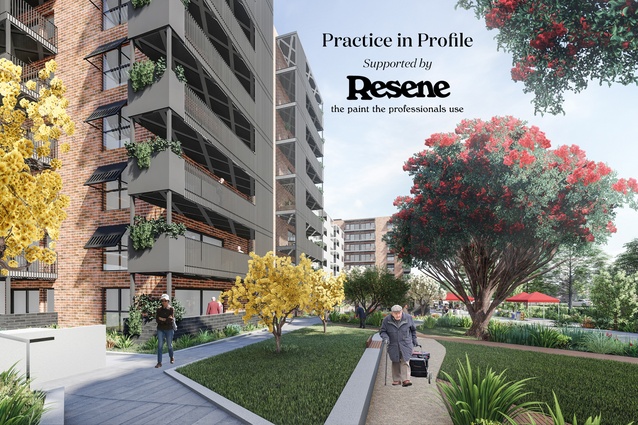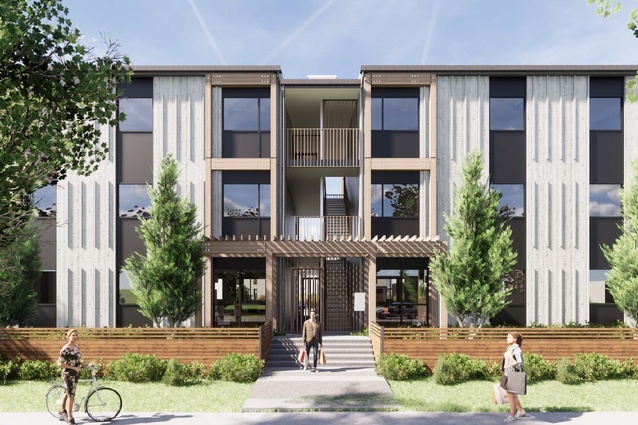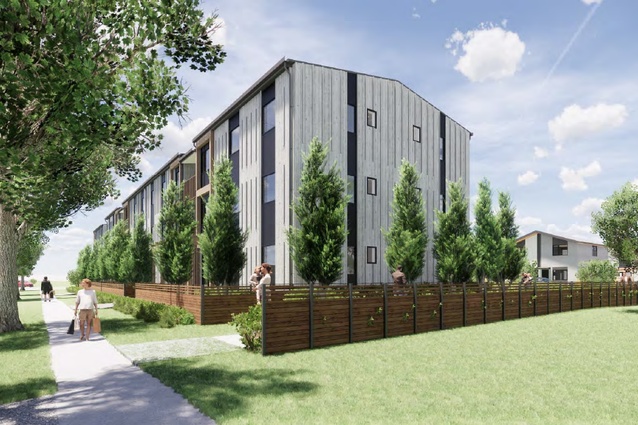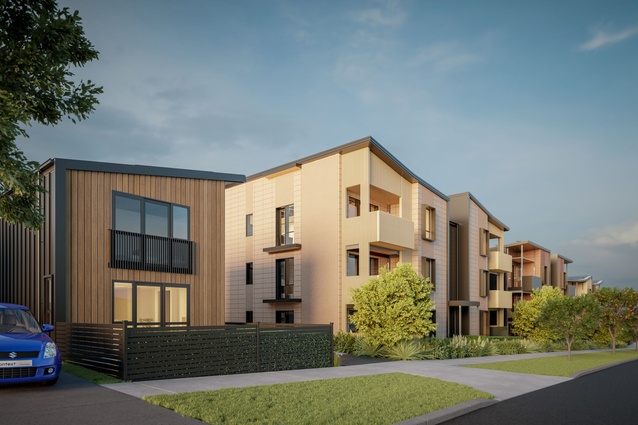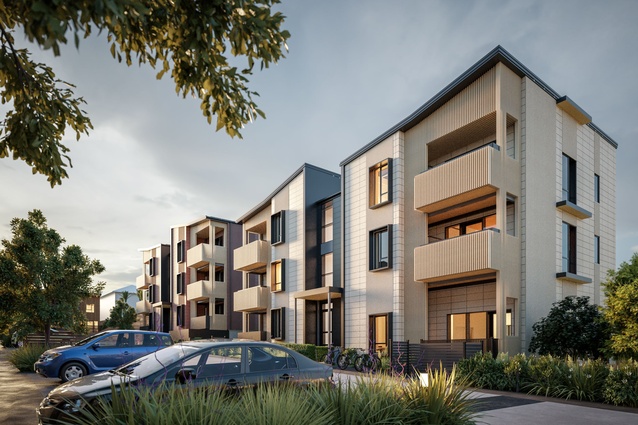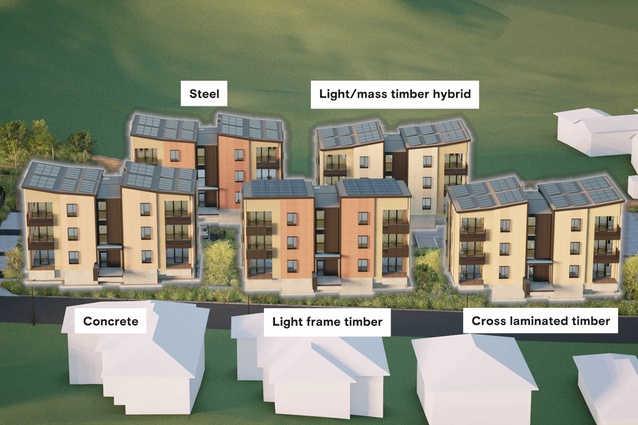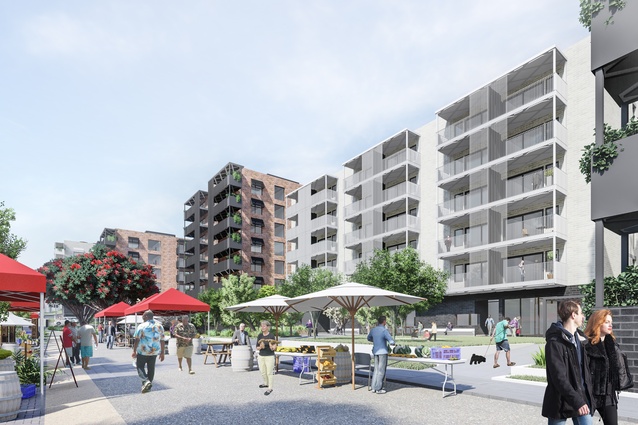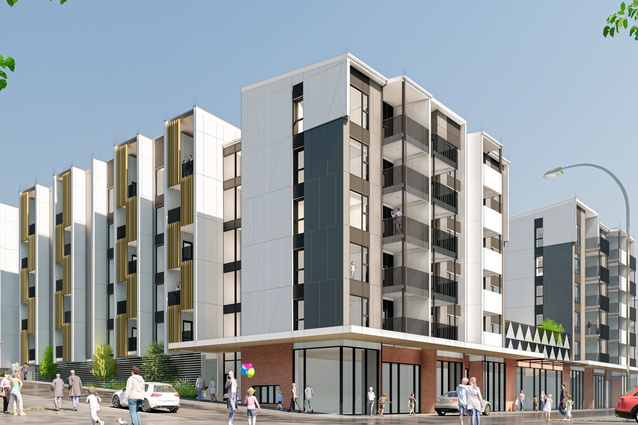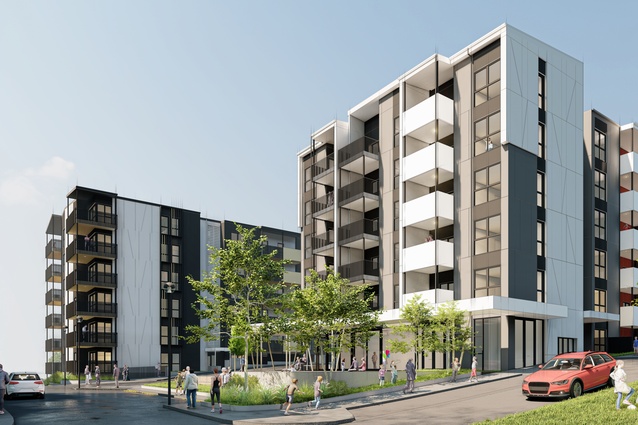State house sustainability
Kāinga Ora – Homes and Communities General Manager Patrick Dougherty explains the recent evolution in public housing and his hopes that it will catalyse change in the residential sector.
It started with a conversation about windows. One of our consultants on the Bader Ventura development suggested that, by using a specific combination of windows and concrete panelling, we might be on the way to achieving Passive House standard.
At that point, in early 2020, Kāinga Ora had already been moving towards more sustainable building practices. This included adopting the New Zealand Green Building Council 6 Homestar rating, or better, for all new homes in 2019.
Ultimately, we are focused on reducing carbon emissions while delivering better-performing homes that are more cost-effective and efficient to build. This is underpinned by our Building Momentum construction strategy document and, more recently, the Ministry of Business, Innovation and Employment’s (MBIE) Building for Climate Change Programme.
Part of the solution lies in embracing advances in new construction methods. Our recently launched offsite manufacturing (OSM) plan outlines the ways in which we are steadily increasing the use of OSM in our housing programme, while playing our part in growing the domestic sector.
We’re also significantly reducing the amount of waste sent to landfill from our development areas, prioritising relocating older homes and deconstruction methods over demolition, where possible. Our Auckland deconstruction panel is being expanded into a national panel and targets to reduce waste created during the construction process will be set this year.
Bader Ventura is among three developments on Bader Drive in Auckland’s Māngere that provide an excellent illustration of our built sustainability journey. The walk-up apartment complexes include one development that achieved a 6 Homestar rating, and another which is targeting a 7 Homestar rating. Bader Ventura, which is under construction, is targeting 8 Homestar and Passive House standard.
We worked initially alongside industry experts to ensure the Passive House higher performance specification would deliver the outcomes and benefits we wanted to achieve, from both sustainability and home occupant perspectives. Once we were satisfied it was the right way to go, the design team rose to the challenge. That collective attitude was key because, in many ways, we are striving to innovate ahead of much of the industry.
Having achieved that design endorsement means Bader Ventura will be Australasia’s first Passive House public housing development funded by central government. It paves the way for further innovation in public housing and beyond.
Accepting the challenge to innovate
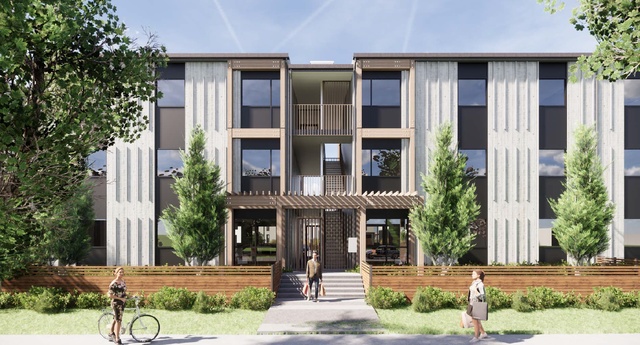
As the Government’s housing and urban development agency, we are responsible for providing homes for people who otherwise might not have one. Those homes need to be of the best quality they can be because there is no denying the positive foundation that a stable, healthy home can bring.
At the same time, we recognise the construction industry, which is responsible for around one-fifth of New Zealand’s carbon emissions, must transform to be more sustainable. With a construction programme moving more quickly than it has done in 40 years, Kāinga Ora is extremely well placed to help lead that change and we need to take calculated risks to show the sector what is possible.
It’s not enough just to build more sustainable homes; we also need great urban design outcomes. The fact that two of our developments were recognised in the 2021 Te Kāhui Whaihanga New Zealand Institute of Architecture Awards is testament to the fact that our strong design principles are being noticed.
We are creating a legacy through our built environment and we are not afraid to pause and ask: “Is there a better way?” An environment of continuous improvement encourages our people to challenge conventional ways of working.
From that conversation about windows, we began to see the Bader Ventura Passive House project as an opportunity to be bold and learn alongside industry partners. As we don’t design or build homes ourselves, we need our partners to help us deliver quality public, affordable and market homes. Our in-house development and project-management teams work alongside external build partners, architects, engineers and other highly skilled consultants, as well as a multitude of subcontractors who contribute to the building of our homes.
Bader Ventura is just one important example of the ways we are working to push the envelope. I will highlight several other multi-level developments where we are adopting new building technologies to deliver healthier homes; they incorporate great amenity into density, improve social and cultural sustainability, and enhance a sense of well-being and connection.
Bader Ventura: Improved liveability
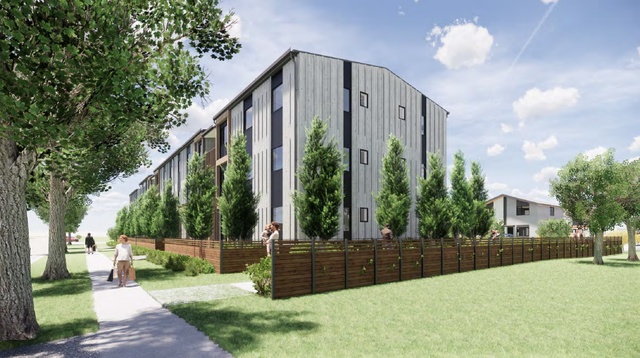
Many of our suppliers and partners share our sustainability ambitions and this was evident in their willingness to strive for Passive House standard at Bader Ventura.
Currently under construction, Bader Ventura will deliver 18 public homes in a three-level, walk-up apartment building by mid-2023. The development sits within the broader Māngere Development, our large-scale project set to deliver around 10,000 new public, affordable and market homes over 15 years.
With fuel poverty a very real issue in New Zealand, delivering public homes to Passive House standard means significant financial and health benefits for our customers. Bader Ventura will reduce heating requirements by around 85 per cent and there will be little need to open windows for fresh air ventilation. This means residents will pay about $1 a day, on average, to heat and cool their homes, as well as receive a continuous flow of fresh, healthy air from the mechanical ventilation system.
The homes are being constructed of low-carbon ‘fly ash’ concrete panels and we are expecting to see reduced operational energy carbon of more than 70 per cent. Passive House is internationally recognised as a best-practice benchmark for low energy use and healthy homes. Achieving this standard with Bader Ventura will also mean reaching MBIE’s Building for Climate Change 2035 final thermal performance cap 12 years ahead of industry expectation.
As well as a reduced operational carbon footprint, we are targeting an 8 Homestar rating – our highest rating to date – and we have other projects in the pipeline also aiming to achieve the same rating or better.
Ngā Kāinga Anamata: Future homes
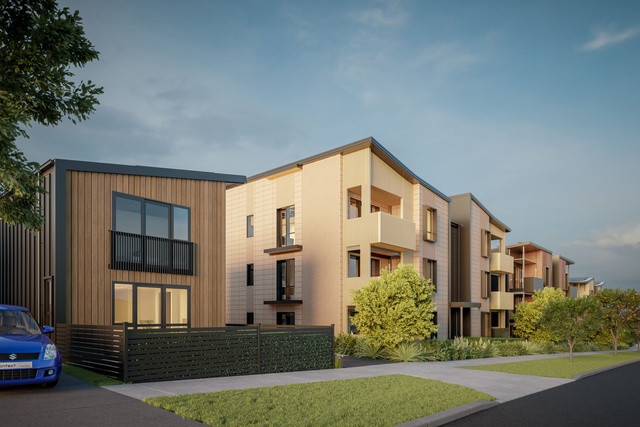
Having shown that we could design to Passive House standard in an already-drawn-up project, we made a start on an even more ambitious project – five buildings using different construction systems, all built to Passive House standard.
Ngā Kāinga Anamata is centrally located in Auckland’s Glendowie and due for completion in 2024. It will deliver 30 two-bedroom public homes within five, three-level walk-up apartment buildings.
The project was showcased as one of only 17 global initiatives in the COP26 Build Better Now pavilion: part of the 2021 United Nations Climate Change Conference. Successful projects were those making an immediate, positive impact on both the planet and people’s lives – outcomes that are critically important to Kāinga Ora, as New Zealand’s biggest property developer and public housing landlord.
This pilot programme, whose name means ‘homes of the future’, seeks to resolve many underlying problems with the housing sector and drive the start of a national response to climate change mitigation in the built environment. Each near-identical building will be constructed using a range of commonly used structural systems and materials. We are aiming to demonstrate that, no matter the material, significantly reduced carbon and energy outputs can be achieved.
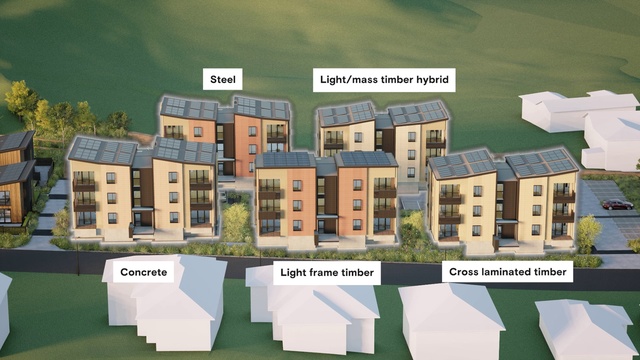
We plan to do this is by focusing on the ‘trifecta’ of low-carbon materials, operational energy-efficient solutions and local renewable energy generation (such as solar panels). The construction and monitoring of the five buildings will help us understand the overall cost and benefits of low-carbon public housing, and report back to the industry to help drive change.
In 2021, the Government announced its intention to halve net greenhouse emissions by 2030. This will contribute towards the international Paris Agreement goal of limiting global warming to 1.5 degrees Celcius above pre-industrial levels. Currently, new residential buildings emit more than five times the carbon that a 1.5°C target allows, meaning we need an 80 per cent reduction in carbon emissions to be climate safe.
Ngā Kāinga Anamata tackles this challenge head-on, aiming to achieve Passive House standard, net-zero energy and a 9 Homestar rating. The project also seeks to address environmental and sustainability challenges, including water scarcity, construction and demolition waste, and biodiversity loss by actively protecting, restoring and supporting local ecosystems.
Planned native biodiversity corridors and large pockets of regenerated native forest will provide a network of plant life supporting insects, birds and other animals to thrive alongside the new development. This work will be carried out in close consultation with the community and mana whenua, and demonstrates our commitment to improving urban ngahere (forest) outcomes across the communities in which we work.
Highbury Triangle: Designing for connection
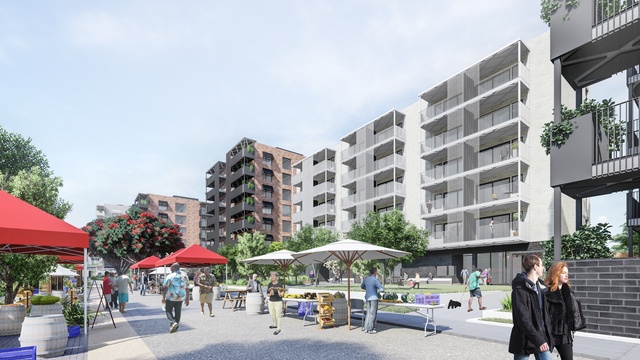
Occupying almost a hectare in the Auckland suburb of Avondale, Highbury Triangle is an excellent example of people-centred design. The predominantly senior living development, which is bordered by Great North Road, Ash Street and Community Lane, will comprise 236 apartments across five buildings of six to eight levels.
Highbury Triangle was conceived in a conventional concrete and steel design, albeit with sustainability initiatives incorporated. However, working with project architects Architectus, we decided early on to finalise the design of one of the buildings in mass timber. Mass timber products are sustainably sourced, efficient to install and enable a reduction in the overall embodied carbon in the development.
Kāinga Ora was one of the first to incorporate cross-laminated timber (CLT) extensively within three-level, walk-up apartments. At Highbury Triangle, we are delivering our first six-level building containing CLT. The inclusion of laminated veneer lumber (LVL) timber framing was proposed by Architectus and Enovate Consultants and developed with input from Built Environs through an early contractor-involvement process. Floor slabs and inter-tenancy walls will be made of CLT, with balcony beams constructed of glulam, another laminated structural technology.
We aim to achieve a 7 Homestar rating at Highbury Triangle. As with Bader Ventura, a mechanical ventilation system will reduce moisture and enable fresh air to circulate. In addition, rooftop solar panels will help provide electricity for communal spaces and apartment hot water cylinders.
Enabling customers to age in place is key, with the entire complex being built to our Universal Design standards, including wider hallways and paths, level access, etc. The 192 senior housing apartments are made up of a mix of one-bedroom and one-and-a-half-bedroom homes, enabling a carer to stay, if required. Mobility parking areas and electric vehicle charging points are also provided with each apartment.
The building fronting Great North Road differs in that it will house small families and couples of all ages. As well as 44, one and two-bedroom apartments, the building will contain ground-floor commercial space, a rooftop terrace and basement parking.
Before we broke ground on the site, the 45 existing dwellings were removed by our contractor TROW Group as part of a deconstruction pilot programme. Approximately 90 per cent of uncontaminated materials were reused or recycled rather than sent to landfill. This exceeds our 80 per cent landfill diversion target (measured by weight) for Auckland public housing developments.
Creating a sense of well-being was an important driver for Highbury Triangle. Ground floor areas are activated in different buildings through a variety of multi-purpose community rooms and facilities where people can connect.
A slow-speed lane, linking Great North Road through to Tait Park, with access out to Rosebank Road, can be cordoned off for gatherings and weekend community markets. The design also prioritised the retention of two mature pōhutukawa and an oak tree, giving an immediate sense of place and complementing the existing trees along Ash Street.
North-facing balconies on each building will incorporate planters, creating a visual connection with the trees to the north, and two rainwater harvesting tanks integrated into the overall stormwater attenuation system will irrigate the gardens and balcony planters.
This connection to nature continues throughout the development with rich native landscaping, communal vegetable and flower gardens, and three glasshouses. One glasshouse will be used to germinate vegetables, another flowers, and the third will contain a social hub with a tea and coffee station.
Exterior design elements further strengthen the sense of place, with Tika Creative displaying Te Kawerau ā Maki local and environmental themes on balcony soffits and within a brick relief artwork on the building fronting Great North Road. The development will be completed from late-2023 to mid-2024.
Arlington: Culture and community through smart design
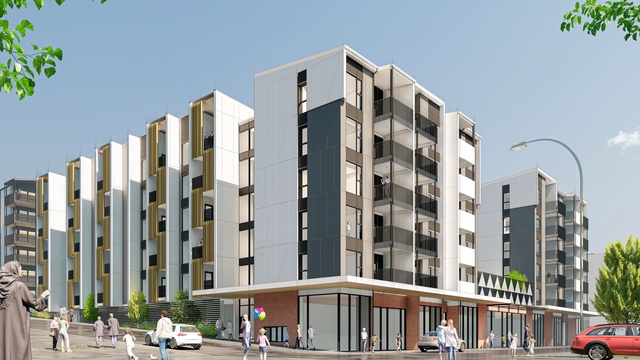
Even in our largest single-site development in Wellington’s Mount Cook, we are challenging convention to lower embodied carbon emissions.
Arlington will see 212 old council apartments transformed into around 300 warm, dry, safe homes. The 17,700m2 site will consist of 16 buildings, ranging from townhouses to six-storey, light-engineered timber apartment blocks.
From the initial briefing, project architects Designgroup Stapleton Elliott (DGSE) recognised that the key to a thriving, sustainable development was to create a distinct design based on a clear urban renewal strategy.
It was more than just designing homes. DGSE used regeneration and spatial design to create spaces and places within the development to help integrate the new buildings and residents into the well-established existing community. Strategically placing the community centre and public park at the heart of the development and weaving the cultural narrative developed by local iwi through the development helps residents build a sense of belonging and connection with their homes and wider community.
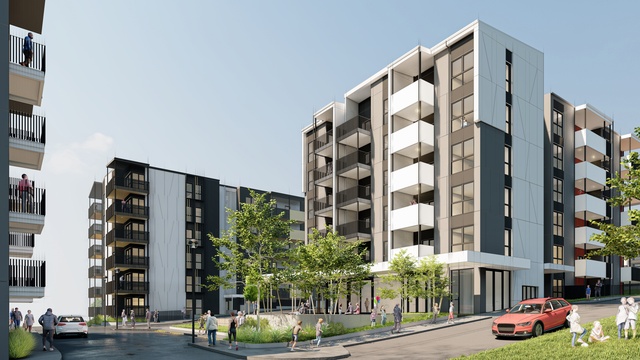
The move away from traditional steel and concrete construction was initiated through an early contractor involvement process with local build partners McKee Fehl Constructors. They undertook an initial assessment of the carbon-dioxide embodied emissions for two of the four six-storey blocks. The findings showed that using light timber frames, when compared with using traditional construction materials, would make energy savings of around 2000 tonnes of CO2 – the equivalent of driving a car 201 times around the earth.
Utilising engineered timber has other benefits too. When the Arlington homes come to the end of their life cycle, it will be easier to disassemble, recycle or repurpose materials, to benefit not only the environment but the local community as well. The offsite manufacturing aspect of modular design also results in build programme efficiencies, such as faster, safer and more predictable procurement, saving time and cost of delivery, and reducing the impact of skilled labour shortages in the Wellington market.
The inclusion of rain gardens, green spaces and electric vehicle charging stations, and the close proximity to mass rapid transport connections will provide residents with sustainable lifestyle options and greater connectivity to the wider Wellington region once the development is complete in 2025.
A joint legacy
Kāinga Ora has been helping to shape New Zealand’s built environment for nearly a century – you need to think only of the instantly recognisable architecture of a post-war state house as testament to this.
While those homes are iconic, we must continue to move with the times. By transforming our operations to respond to the challenges of climate change, we want to help enable system change and demonstrate to the industry the ways in which we can all deliver quality homes, which not only look great but also perform better and are more cost-effective.
But, the flipside is that Kāinga Ora doesn’t design or build homes. To achieve innovation, we need our partners in design and construction to work alongside us, challenging us and suggesting ways we can go further. As was the case with those windows at Bader Ventura.

Patrick Dougherty is General Manager for the Kāinga Ora Construction and Innovation group, which is charged with delivering more than 2400 new public homes a year, alongside industry partners. The group also reconfigures and renews parts of the national Kāinga Ora housing portfolio of more than 68,000 homes. It pursues innovations in technology, and undertakes research and development, to enable Kāinga Ora to deliver better and brighter homes and communities.

